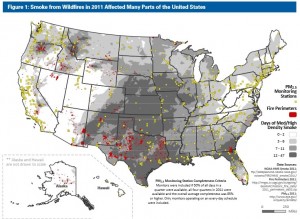Smoke But No Fire? Report Looks at Smokiest Counties in 2011
Texans know all too well the devastation that wildfires bring to land, property, and community. Now, research claims to show how smoke from those fires could pose hazards hundreds of miles away, though researchers say there is a need “to look more closely” at the data.
The study was conducted by the Natural Resources Defense Council, an environmental group that looked at NOAA satellite smoke plume maps from 2011 to gauge where heavy concentrations of smoke could affect people’s health. Its findings: many Americans lived in areas impacted by smoke even if they lived far from wildfires.
“Nearly 212 million Americans lived in counties affected by smoke conditions at some time in 2011,” Kim Knowlton, an NRDC environmental health staff scientist and Columbia University Professor said in a telephone press conference.
“The areas affected by smoke totaled fifty times larger than the immediate fire areas,” she added.
1) Texas: more than 25 million people lived in areas with smoke conditions for one week or more.
2) Illinois: 11.9 million residents in affected areas.
3) Florida:11.2 million residents in affected areas.
4) Missouri: 5.9 million residents in affected areas.
5) Georgia: 5.7 million residents in affected areas.
Knowlton said in 2011 twenty five million people were affected in Texas alone, not surprising considering how many wildfires hit the state that year. The study points to research that has linked particulate matter from smoke to health problems.
“On days with high smoke levels there is a greater risk of lung problems such as those experienced by asthmatics,” Dr. Patrick L. Kinney, Director of the Columbia Climate and Health Program, said at the same press conference. “In addition it’s very likely that fire smoke can also increase the risk of premature death due to heart and lung problems to a small extent.”
But the report faced skepticism from some reporters at the telephone news conference.
For example, while it purported to measure wildfire smoke, Bryan Thompson from Kansas Public Radio pointed out that much of the smoke in his state could have come from controlled prairie burns and agricultural fires, a fact not noted in the report.
Knowlton conceded the point saying the study was “not intended to be a source and diffusion kind of exercise.”
“I think that it points to a desire to look more closely and further at our burns across the country,” she said.
